Germinating Grass Seed: How to Get the Perfect Start for Your Lawn
Even the best of us are sometimes impatient. Having planted our grass seeds, waiting for germination and our gorgeous green lawn to appear can be frustrating? The question is how can we optimize the process so that the seeds start germinating when put down.
Well, it all starts with nurturing tiny life underground. Those little grass seeds are like nature’s sleepyheads, waiting for the perfect conditions to wake up and sprout. While the air temperature might seem important, the real magic happens beneath the surface – the soil temperature is what truly wakes them from their slumber!
Just like we need a warm cup of coffee to kickstart our day, those grass seeds need the right warmth in the soil to germinate. So, ditch the air thermometer and let’s dive into the fascinating world of soil temperature for grass seed germination!
Having been involved with the establishment of 100’s of lawns over the years, I can’t stress enough how vital it is to understand the optimal soil temperature for your chosen grass type. Whether you’re planting cool-season grasses like Kentucky Bluegrass or warm-season varieties like Bermuda, the temperature of the soil can significantly impact how well your seeds germinate. Get it right, and you’re on your way to a lawn that not only looks good but is also resilient and low-maintenance. Get it wrong, and you could be facing a season of patchy, uneven growth, or worse, seed failure.
Why Knowing Grass Seed Germination Temperature Is Essential
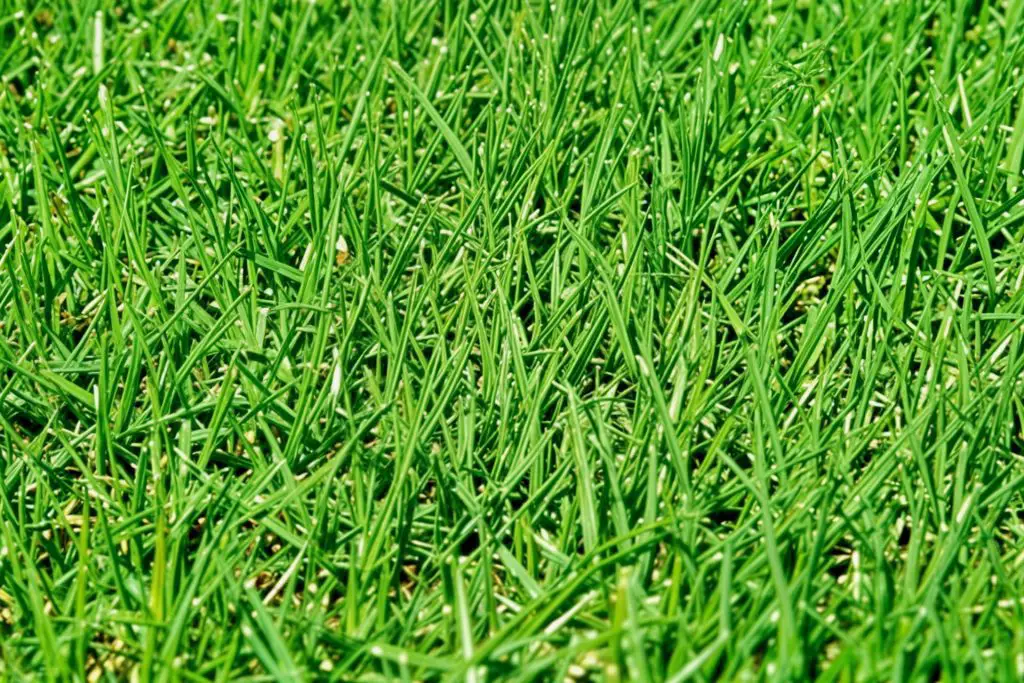
When planting grass seed it is essential to know whether the soil temperature. If it is too cold or too hot the seed will fail to germinate or to germinate properly. So, what is the right grass seed germination temperature?
There is no single answer to this as it largely depend on the type and variety of grass seed that you are growing. Some grass varieties only grow in warmer temperatures and these are known as warm-season grasses. Other varieties grow in much cooler conditions and won’t grow below and above certain temperatures and these are known as cool-season grasses.
If you’re planting cool-season grass, the soil temperature should be above 45°F, however, root development may tolerate temperatures to as low as 40°F.1 Cool-season grasses also go dormant where temperatures are above 90°F. Warm-season grasses need soil temperatures between 60° and 65°F to germinate.2
Optimal Grass Seed Germination Temperature Chart
When it comes to grass seed germination, knowing the optimal soil temperature for your specific grass type is crucial. This chart serves as a quick reference guide, helping you choose the right grass for your lawn based on soil temperature and the best planting season.
| Grass Type | Optimal Soil Temperature | Best Planting Season |
|---|---|---|
| Kentucky Bluegrass | 60-70°F | Fall (after soil cools) |
| Fine Fescue | 60-70°F | Fall or Spring |
| Tall Fescue | 60-75°F | Fall or Spring |
| Ryegrass (Perennial) | 55-70°F | Fall or Spring |
| Ryegrass (Annual) | 40-70°F | Fall |
| Bermuda | 70-85°F | Spring or Summer |
| Zoysia | 70-80°F | Spring or Summer |
| St. Augustine | 75-85°F | Late Spring or Summer |
| Bahia | 70-80°F | Spring or Summer |
| Centipede | 75-85°F | Spring or Summer |
| Buffalo Grass | 70-80°F | Spring or Summer |
At What Temperature Does Grass Seed Germinate
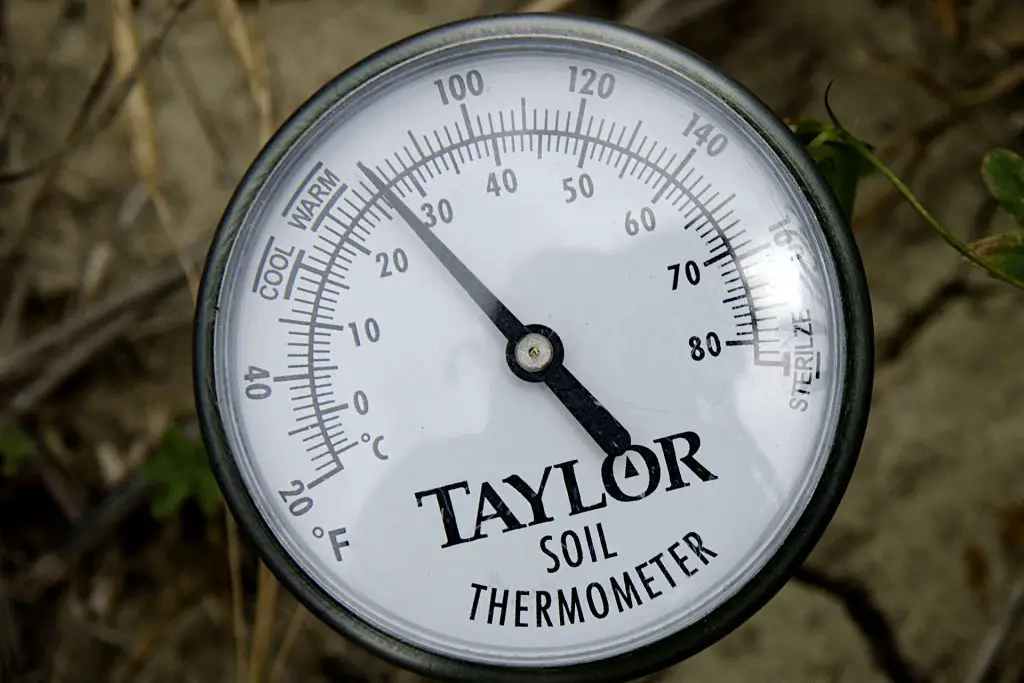
Temperature is by far the most essential factor in determining grass seed germination. Grass seeds require the soil temperature to be within a certain range in order for germination to occur. This range depends on the type of grass seed that you are planting, either cool-season grass or warm-season grass.
Air Temperature vs Soil Temperature
When we talk about the temperature it is important not to get confused with air temperature. Whilst the daytime temperature impacts the temperature of the soil, the soil itself retains heat far longer than the air does.3 Daytime and night temperatures can vary considerably whereas the soil’s temperature will remain fairly constant.
It is also significant to note that soil temperature can take time to catch up to that of air. If you have had a cold spell and the daytime temperature suddenly increases, you will likely find that the ground temperature can be much colder. You could have a situation where there is a brief warm weather period, such as with a ‘false spring‘, where the soil will not become warm enough for the seed to germinate as expected as the soil is too cold.
It is therefore not unusual to find the temperature of the soil is different from that of the air. So, whilst climatic temperature can give you an idea when it comes to planting grass seed it is best to determine the soil temperature using a soil thermometer.
Seasonal Planting Advantages
Timing is everything. When it comes to getting the right soil temperature picking the perfect season to plant can make all the difference.
Fall: Imagine this – the heat of summer has passed but the soil still holds onto that cozy warmth. That’s fall for you, and it’s the prime time for planting cool-season grasses like Kentucky bluegrass or tall fescue. In fall, the warm soil encourages quick germination while cooler air temperatures are kinder to young shoots. Plus, you’ve got the winter months ahead for the roots to establish themselves deeply, setting up a lush, green comeback for spring.
Spring: For those living in warmer climes where winters can freeze a blade of grass in its tracks, spring planting is your go-to. As the frost recedes and the soil warms, it’s the perfect backdrop for warm-season grasses such as Bermuda and Zoysia. Starting your seeds in spring means they’ll have the entire summer to flourish. Just be wary of late frosts and ensure your seeds have enough time to establish before the scorching summer heat.
Choosing the right season for planting enhances the chance of your soil maintaining the correct temperature and minimizes the lawn’s stress. Plus, there’s something deeply satisfying about aligning your gardening with the rhythm of the seasons, isn’t there? It feels like you’re working with nature, not against it.
Warm-Season Grasses
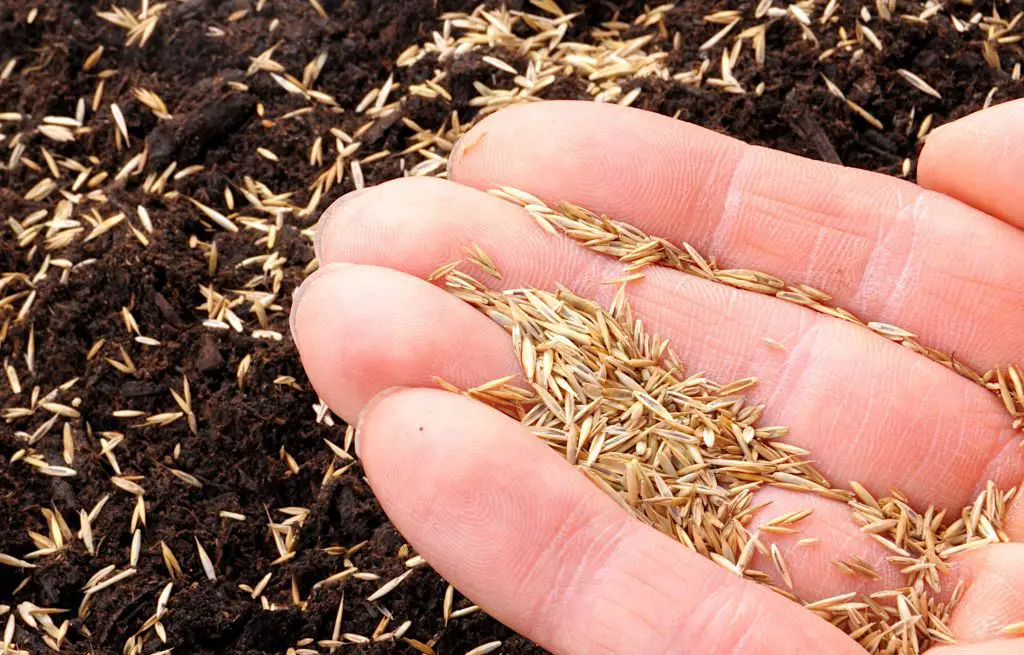
Warm-season grass should be planted in warmer climatic conditions. They begin to germinate and show root activity when temperatures reach 60°F to 65°F. Below this temperature, the grass remains dormant and the seeds won’t germinate. Its peak growing temperature for leaf growth is between 80° to 95°F
When it comes to planting warm-season grass, late spring is often considered the best time. You should look to plant when the soil temperature reaches 65° to 75°F. The grass should then be already established so that when the heat of summer arrives top growth can thrive fully establishing your lawn.
Cool-Season Grasses
Cool-season grasses thrive in more temperate conditions and can struggle in warmer climates. Root development can be triggered with temperatures as low as 40° to 45°F, although the optimum temperature range for leaf growth is between 65° to 75°F.
However, cool-season grasses struggle in warmer temperatures. Once the temperature exceeds 75°F growth slows down, with it becoming dormant when temperatures exceed 90°F.
In terms of planting cool-season grass varieties, the best germination rates are achieved when temperatures range from 50°F to 65°F. Fall is often considered the best time to plant cool-season grasses. You need to leave a window where there are at least eight weeks before temperatures drop to below 45°F to give the grass enough time to establish itself as grass seedlings are vulnerable to frost and freezing weather.
Grass Seed Mixtures

If you are in a transitional zone it is not uncommon to look to use grass seed mixtures to provide a better lawn that can adapt to transitional conditions. In terms of germinating the sweet spot would be between 60° to 70°F to ensure both the warm and cool season seeds can germinate in unison.
Spring is likely to meet this criterion best as this will allow the cool season grass to establish itself before the hot weather. Although it would also be possible to plant in late summer or early fall other criteria, such as daylengths,4 could impact on warm-season grass seedlings growth.
How to Measure Soil Temperature: A Step-by-Step Guide
The most reliable method is to use a soil thermometer. Below is a step-by-step guide to help you accurately measure soil temperature, ensuring your grass seeds have the best chance for successful germination.
Digging for Answers: How to Use a Soil Thermometer
So, we’ve established that soil temperature is the secret handshake for waking up those sleepy grass seeds. But how do we actually find out what’s brewing down there? Here’s where our handy friend, the soil thermometer, comes in!
Think of it like a tiny detective for the underground world. It dives in and gets the dirt (literally!) on the temperature. Using a soil thermometer is a breeze, and here’s how to become a soil temperature sleuth:
Tools You’ll Need
- Soil thermometer
- Garden trowel
- Notepad or mobile device for recording measurements
Process
- Grab your trusty thermometer: They’re usually pretty affordable and readily available at garden centers or online.
- Head to your planting zone: Choose a representative area where you plan to plant your seeds.
- Dig a little investigation hole: Just shove a small hole in the soil, about as deep as you’ll be planting your seeds (usually around 2-3 inches).
- Insert the thermometer detective: Gently push the probe of the thermometer all the way down the hole.
- Wait for the verdict: Hold on tight for a minute or two – that’s how long it takes for the thermometer to get an accurate reading of the soil temperature.
- Voila! The dirt on the dirt! Pop out the thermometer and check the reading. Now you know the secret handshake for those grass seeds!
Pro Tip: Soil temperature can fluctuate throughout the day, especially near the surface. To get a more accurate picture, consider taking a few readings in different areas and at different times of the day. This will give you a better idea of the overall soil temperature where your future lawn will be.
If you are consistent in your method, you’ll gain a more precise understanding of your soil’s temperature, allowing you to make informed decisions for successful grass seed germination. In addition, by measuring the temperature regularly and keeping logs you will be able to build up a picture of temperature changes throughout the seasons, which will improve your lawn care maintenance practices.
Beyond the Warm Blanket: Other Germination Necessities
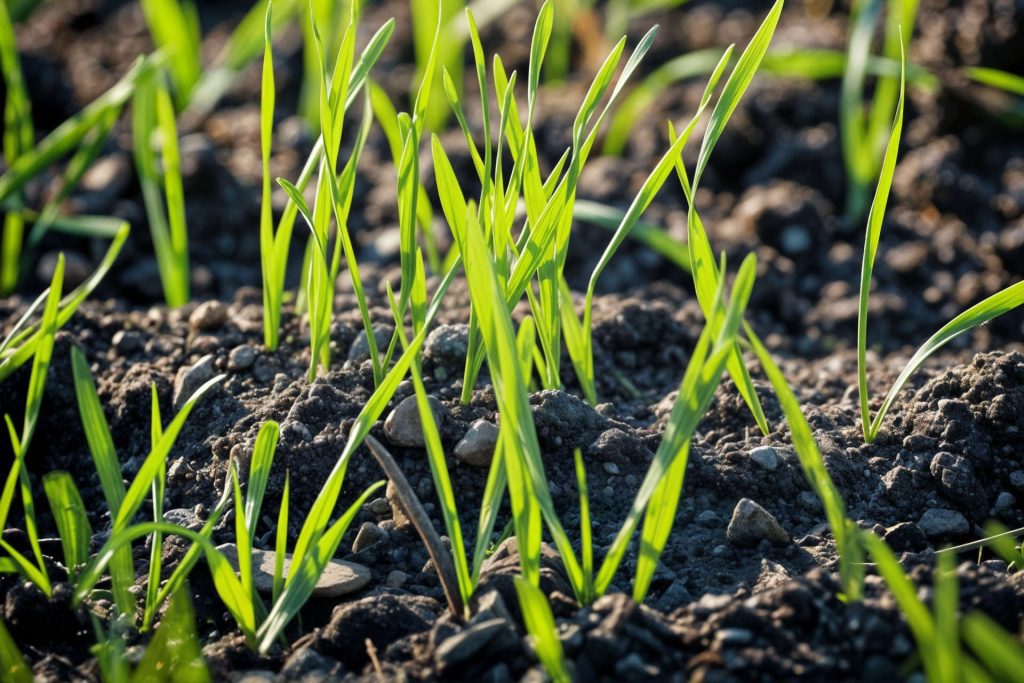
Sure, soil temperature is the key to waking up those sleepy grass seeds, but it’s not the only factor in play.
Soil Preparation
Let’s not forget the foundation of it all: the soil itself! Think of it as the cozy nursery where your grass seeds will take their first steps towards becoming a thriving lawn. Just like a comfy bed is great, but a supportive mattress is even better, good quality soil makes all the difference in germination success.
Here’s where a little pre-planting TLC goes a long way. Taking some time to prepare the soil will ensure it has the right structure, nutrients, and pH balance to give your seeds the best possible start. Consider adding some organic matter like compost or aged manure as these will add essential nutrients that will fuel the growth of your future lawn.
Depending on your soil test results, you might also want to consider using specific products to adjust the pH balance. Remember, some grass types prefer slightly acidic or slightly alkaline soil, so achieving the right balance can significantly impact germination rates.
Power of Sunshine:
Think of sunlight as the energy booster for your seeds. Different grass types have varying needs, but most cool-season grasses like Kentucky Bluegrass and Fescue enjoy at least 6-8 hours of sunlight per day. Warm-season grasses like Bermuda and Zoysia, on the other hand, are sun worshippers and crave as much sunshine as they can get! So, before you plant, consider the amount of sunlight the area receives and choose a grass type that will flourish in those conditions.
Daylight Length:
This one might sound a bit strange, but believe it or not, the length of daylight plays a role in germination too. Some cool-season grasses actually require a certain amount of shorter days (think fall) to trigger their internal “sprouting clocks.” Warm-season grasses, however, tend to thrive with longer days (think summer). Understanding the natural daylight patterns of your location will help you choose the right time to plant for optimal germination success.
Watering Consistency:
Watering is crucial, but it’s all about finding the sweet spot – not too much, not too little. Think of it like Goldilocks and the seeds: too much water can drown them, while too little will leave them parched and unable to sprout.
The frequency and amount of watering will depend on your soil type, climate, and the specific grass variety you choose. Generally, you want to keep the soil consistently moist, but not soggy. A light daily watering in the early morning is often ideal, but adjust based on your specific conditions.
Read the Packet
Grass seed containers or sacks often have valuable information on sunlight, daylength, and watering needs for the specific grass type you’ve chosen. Don’t hesitate to consult this information for the most accurate care tips for your future lawn.
Although temperature and moisture are the triggers for germination to start. Once you have planted your seed other factors such as sunlight, daylengths, and adequate moisture can and will determine the germination rate.
Where Soil Temperature Affected Grass Seed Germination
Case Study 1: The Tale of Two Neighbors
Background
John and Sarah, are near neighbors who both decided to plant Kentucky Bluegrass in their front yards in northern Pennsylvania . John, an avid gardener, who had previous experience of seeding a new lawn, took the time to measure the soil temperature before planting deciding that Fall was the optimum time. Unfortunately, Sarah having seen John’s lawn but had not spoken with her neighbor or consulted a lawn specialist instead planted her seeds based on the notion that spring was the perfect time.
Outcome
John’s lawn created a lush and vibrant lawn, while Sarah’s experienced patchy growth. The difference? Soil temperature. John waited until the soil consistently hit the optimal germination temperature of 60-70°F, ensuring uniform germination. Sarah’s soil was cooler, leading to delayed germination which caused her to end up with uneven growth.
Key Takeaway
Understanding and measuring soil temperature can lead to consistent and successful seed germination, saving both time and resources in the long run.
Case Study 2: A Rookie Mistake
Background
Tim, a new homeowner in Wichita was keen to get his lawn down as soon as possible. He decided to plant Zoysia grass, a warm-season variety but ignored advice on soil temperature, and planted the seeds in early spring when the nights were still cool.
Outcome
Tim’s seeds experienced very poor germination rates. Zoysia grass is a variety that needs soil temperatures to be at between 70-80°F for optimal germination. Tim’s soil was well below this range, leading to seed wastage and a need for replanting.
Key Takeaway
For warm-season grasses like Zoysia, soil warmth is crucial. Planting without considering soil temperature can lead to wasted seeds and additional costs.
By examining these case studies, it becomes evident that soil temperature plays a pivotal role in the success of grass seed germination. Whether you’re a homeowner or a professional landscaper, understanding this vital factor can make the difference between a thriving lawn and a lackluster one.
One point to note is that poor germination does have other causes, particularly the viability of the seeds but in both Sarah and Tim’s cases the seeds were bought them to plant so in it was not the issue with eithers poor germination rates.
Troubleshooting Guide: Solving Common Germination Problems
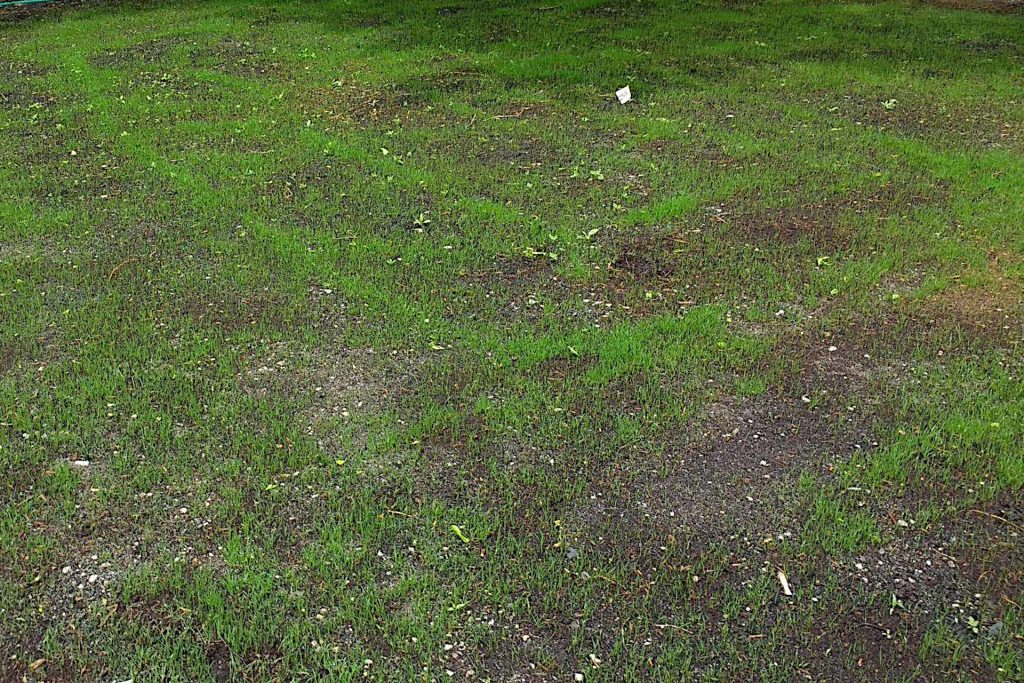
Even with the best preparations, you might encounter some hiccups along the way to achieving that perfect lawn. Don’t worry; you’re not alone. In this troubleshooting guide, we’ll address common issues like uneven germination and seed rot, offering practical solutions to get your lawn back on track.
Uneven Germination: A Patchy Problem
| Category | Details |
|---|---|
| Symptoms | – Sporadic patches of grass – Inconsistent growth across the lawn |
| Common Causes | – Inconsistent Soil Temperature: Variations in soil temperature can lead to uneven germination. – Poor Seed Distribution: If seeds are not evenly spread, they won’t germinate uniformly. |
| Solutions | – Recheck Soil Temperature: Use a soil thermometer to ensure consistent temperature across the lawn. – Overseed: Apply additional seeds to the bare patches, ensuring even distribution. – Level the Soil: Uneven soil can lead to temperature variations. Level it out for consistent germination. |
Seed Rot: The Unseen Enemy
| Category | Details |
|---|---|
| Symptoms | – Foul smell from the soil – Seeds appear mushy and discolored |
| Common Causes | – Overwatering: Excessive moisture creates a breeding ground for fungi. – Poor Drainage: Soil that doesn’t drain well can lead to waterlogged conditions. |
| Solutions | – Adjust Watering Schedule: Reduce the frequency and amount of watering. – Improve Drainage: Amend the soil with organic matter like compost to improve its drainage capabilities. – Apply Fungicide: Use a lawn-safe fungicide to treat the affected area. |
Additional Tips
- Soil Testing: If you’re facing persistent issues, consider a comprehensive soil test to check for nutrient imbalances or pH levels that could be affecting germination.
- Consult a Professional: For severe or recurring problems, it may be beneficial to consult a lawn care expert for a tailored solution.
Below is a chart that can serve as a quick reference guide to help you identify and solve common problems that may arise during the grass seed germination process. From uneven growth to seed rot, here’s how to tackle these issues head-on.
| Problem | Likely Cause | Solution |
|---|---|---|
| Uneven Germination | Inconsistent Soil Temperature | Recheck soil temperature and level the soil for uniformity. |
| Poor Seed Distribution | Overseed the bare patches, ensuring even distribution. | |
| Seed Rot | Overwatering | Adjust watering schedule to prevent excessive moisture. |
| Poor Drainage | Amend soil with organic matter to improve drainage. | |
| Slow Germination | Low Soil Temperature | Wait for optimal soil temperature or consider soil warming techniques. |
| Old or Expired Seeds | Use fresh seeds with a high germination rate. | |
| Patchy Growth | Inadequate Sunlight | Trim overhanging branches or consider relocating to a sunnier spot. |
| Nutrient Deficiency | Conduct a soil test and amend soil as needed. | |
| Seedlings Dying | Fungal Diseases | Apply a lawn-safe fungicide and improve soil drainage. |
| Pest Infestation | Use a lawn-safe pesticide and consider natural pest deterrents. |
Wrap-Up: What Is the Right Grass Seed Germination Temperature?
As we have seen it is soil temperature and not air temperature that is important when it comes to the point at which grass seeds will germinate or remain dormant.
Cool-season grass seeds will germinate at temperatures as low as 40°F but they germinate at the fastest rate between 50°F and 65°F. Warm season grass seeds, on the other hand, need the soil temperature to be at least 60°F to germinate, but germinate at their fastest rate when the temperature is between 65° to 75°F.
Ultimately, the best time to plant grass seed is when the grass type lines up with the optimal temperatures for the fastest germination as it will allow grass seedlings will appear sooner and the lawn can be established faster.
Notes
- Pennsylvania State University, Peter Landschoot, Professor of Turfgrass Science: The Cool-Season Turfgrasses: Basic Structures, Growth and Development ↩︎
- Oregon State University, Department of Crop and Soil Science: Cool-season or Warm-season Grasses ↩︎
- Prudue University, Aaron J. Patton: A Guide to Establishing Seeded Zoysiagrass In the Transition Zone ↩︎
- Oregon State University, Department of Crop and Soil Science: Cool-season or Warm-season Grasses ↩︎
